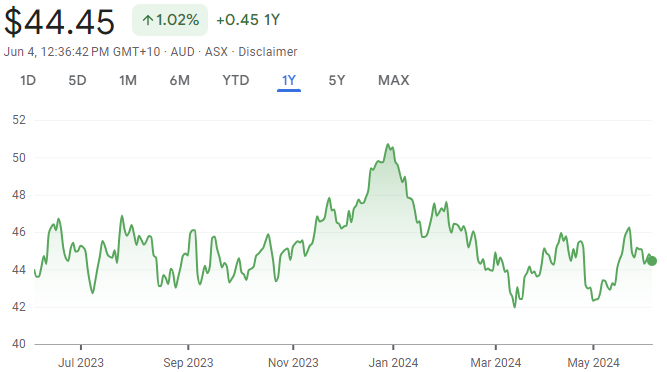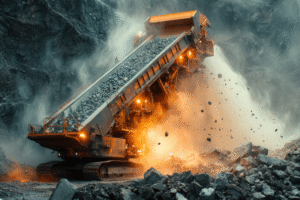BHP Share price forecast: What’s ahead for the company in 2024 and 2025?
![]() Ujjwal Maheshwari, June 4, 2024
Ujjwal Maheshwari, June 4, 2024
The stock market is always full of surprises, with BHP Group Limited (ASX: BHP) capturing plenty of attention lately. In May, the BHP stock climbed to $44.51, showing a commendable 3.4% increase from April. This growth outperformed the slight 0.5% rise in the broader S&P/ASX 200 Index (ASX: XJO), indicating a robust market confidence in the company’s prospects.
How has the BHP performed till now?
BHP’s strong performance in May was underpinned by steady demand for industrial metals like iron ore and a significant rise in copper prices. Iron ore, the backbone of the company’s revenue, was priced between US$116 and US$118 per tonne. Copper, also a vital asset for the company, reached new highs by the month’s end at US$10,040 per tonne, increasing by 3%. The health of these commodities is vital for the stock and its financial success, as the market performance directly impacts the company’s share price.
The Failed Bid for Anglo-American
One notable development in May was BHP’s unsuccessful efforts to purchase Anglo American (LSE: AAL). The company made a series of offers, escalating to a final bid of approximately $74 billion. Despite the substantial offers, Anglo American’s board turned them down, pointing to issues with the bid’s structure and what they considered an undervaluation of their future growth potential. Although this news introduced some fluctuations in BHP group stock price, the overall investor response was relatively subdued. This calm suggests that investors still have faith in BHP’s strategic vision, particularly its emphasis on future commodities like copper and essential minerals.

Market Sentiment and the Role of Commodity Demand
The demand for commodities significantly influences the price movement of BHP shares. Recently, the price of copper has risen sharply, fueled by growing demand in sectors such as electric vehicles and energy transition initiatives, which in turn has bolstered the stock. Moreover, economic measures in China, including the issuance of 1 trillion yuan in bonds to spur infrastructure investments, have brightened the demand outlook for commodities like iron ore and copper. These factors combine to paint a positive picture of BHP’s market standing.
What BHP’s Price Chart Says?
A closer examination of BHP’s stock chart shows significant fluctuations. So far this year, the shares have seen a 13% decline, which mirrors broader market movements and reflects specific challenges facing the company. Despite this, technical analysis highlights that the shares have a strong support level at around $44 per share. This stability suggests a potential floor for the stock price in the near term. If BHP can hold this support level, it may attract additional investors looking for opportunities, potentially driving up the stock price.
So, can we consider BHP as an Investment Option?
Looking at historical data, BHP has consistently been a robust performer, with an average annual return of 10.8% over the past ten years. This performance has surpassed that of the Vanguard Australian Shares Index ETF (ASX: VAS), which has returned 7.6%. The company’s impressive track record, coupled with its substantial, fully franked dividends, makes its shares attractive to long-term investors. However, investors should be aware of the stock’s significant dependence on commodity prices, which adds a layer of volatility to its stock.
Future Prospects and Copper Focus
BHP is strategically aligning itself with the shift toward sustainable and greener technologies, emphasizing the importance of copper in this transition. A key move in this direction is the acquisition of South Australian copper miner Oz Minerals for $6.4 billion, which highlights the company’s dedication to strengthening its copper assets.
Additionally, holding a majority stake in Chile’s Escondida mine, the world’s largest copper mine, positions BHP advantageously to meet the growing global demand for this critical mineral, essential for technologies like electric vehicles and renewable energy solutions.
Dividend Outlook is Solid
BHP’s robust financial health is reflected in its final dividend strategy, which prioritises substantial returns to shareholders. According to forecasts from Goldman Sachs, the company is expected to issue fully franked dividends of US$1.45 per share for FY 2024, translating to a yield of 5.1%.
Despite this strong return, analysts like those at UBS predict a gradual tapering of BHP dividends over the next few years, aligning with an anticipated softening in earnings. Specifically, UBS projects a decline in the company’s net profit after tax from US$13.5 billion in FY24 with earnings per share at US$2.66 to US$9.66 billion by FY28—a 30% decrease.
The stock’s earnings and stock forecast are significantly influenced by commodity prices, particularly iron ore. However, this outlook could be compromised if iron ore prices stabilize around US$100 per tonne, potentially undercutting profitability. Looking ahead to FY26, UBS forecasts a decline in profit to US$12.1 billion, with annual earnings per share expected to decrease to US$2.38.
Nicely diversified
BHP’s earnings largely hinge on the prices of commodities like iron ore and copper, which can swing quite a bit. These swings have a direct impact on its earnings. While iron ore prices have been up and down, causing some uncertainty, copper provides a steadier outlook because of its crucial role in the growing fields of renewable energy and electric vehicles. This mix of stability and volatility shapes BHP’s financial health.
The world is pushing towards using more renewable energy and less carbon, which means a higher demand for essential minerals, especially copper. Copper is critical in technologies like electric vehicles and green energy solutions. Bhp’s focus on copper and other important minerals puts it in a good position to benefit from these big changes in the industry, potentially leading to better stock performance.
So, what to expect in the next 12 months?
BHP’s stock price is influenced by various elements, including how much commodities are in demand, the overall mood of the market, and the company’s own business moves. Though the company’s ongoing efforts to grow its future-facing commodities, like copper business and capitalise on the shift to greener technologies look promising for future growth, when thinking about investing in BHP and the company’s performance, our investment advice would be to look at both the big picture and the finer details of the stock, including commodity prices and the company’s strategic steps.
For those considering investing in BHP shares, invest money now as it seems to be a good time. With its strong track record and a forward-looking approach, this stock remains an attractive option in the mining sector and can be considered a good stock. The ongoing changes in the commodity markets and BHP’s proactive strategies make it a stock worth keeping an eye on.
What are the Best ASX Mining Stocks to invest in right now?
Check our buy/sell tips
Frequently Asked Questions
- What is the BHP share price forecast for 2025?
The BHP share price forecast for 2025 projects an average price of $47.26. Analysts estimate a high of $61.55 and a low of $32.96, reflecting varied expectations based on market conditions and commodity prices. This forecast highlights the potential growth and market fluctuations affecting BHP’s stock in 2025.
- How will commodity prices impact BHP’s share price in 2025?
Commodity prices, especially for iron ore and copper, will significantly impact BHP’s share price, with higher prices potentially boosting earnings and share value.
- What is BHP’s strategic focus for future growth?
BHP’s strategic focus includes increasing copper production, vital for the renewable energy sector, and maintaining a stable dividend policy to attract investors.
- What factors influence BHP’s share price forecast?
Factors include global commodity demand, operational efficiency, market conditions, and geopolitical events affecting commodity prices.
- How does BHP’s dividend policy affect its share price?
BHP’s stable and attractive dividend policy appeals to income-focused investors, positively impacting its share price by increasing investor demand.
Blog Categories
Get Our Top 5 ASX Stocks for FY26
Recent Posts
Larvotto Resources is fully funded for its $694M Hillgrove Project
18% Jump for Larvotto Resources as Hillgrove Construction Moves Ahead, Backed by $175M in New Funding Larvotto Resources (ASX: LRV)…
Archer Materials Cracks Quantum Readout Challenge as Stock Surges 12%
Archer Materials Just Solved One of Quantum Computing’s Hardest Problems Archer Materials (ASX: AXE) jumped 12% today after unveiling two…
NVIDIA’s Blackwell Chips Ignite Record Demand in Q3
NVIDIA’s Blackwell Surge Tech investors and growth-focused funds will be breathing a sigh of relief after NVIDIA (NASDAQ: NVDA) delivered…



